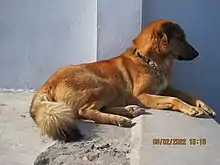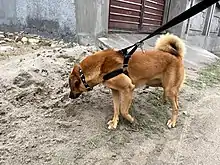Bakharwal dog
The Bakharwal dog is a livestock guardian dog found in northern India.[1][2][3] It is an ancient working Indian dog breed found in Ladakh and across the Pir Panjal Range of India, where it has been bred for many centuries by the Bakarwal Gujjar nomadic tribe as a livestock guardian dog and settlement protector.[4][5] While the Bakharwal Dog is mainly found in India, it is found in smaller numbers in Afghanistan and Pakistan.[6]
| Bakharwal Dog | |||||||||||||||||||||||||||||||
|---|---|---|---|---|---|---|---|---|---|---|---|---|---|---|---|---|---|---|---|---|---|---|---|---|---|---|---|---|---|---|---|
 female bakarwal | |||||||||||||||||||||||||||||||
| Other names | Bakerwal, Bakerwal Mastiff, Gujar Dog, Gujar Watchdog, Kashmiri Sheepdog, Kashmiri Bakerwal Dog, Kashmiri Mastiff[1] | ||||||||||||||||||||||||||||||
| Origin | Indian subcontinent | ||||||||||||||||||||||||||||||
| Breed status | Not recognised as a breed by any major kennel club. | ||||||||||||||||||||||||||||||
| |||||||||||||||||||||||||||||||
| Dog (domestic dog) | |||||||||||||||||||||||||||||||
A recent study says that this breed is on the verge of extinction and Bakerwal community has appealed to include this animal in the endangered species category. Of late, there were many cases when this mountain breed of dog contracted rabies or was shot by separatist militants.[4][7][8]
History

The origin of the Bakharwal Dog lies in Ladakh, northern India, and found in the states of Jammu and Kashmir and Himachal Pradesh.[9][4] It has been bred by the Gujjar and Bakerwal castes, as well as other local people of Jammu and Kashmir and Himachal Pradesh, for the purpose of guarding their flocks of goats, sheep and cattle, along with their houses, from centuries.[4] The Bakharwal Dog may be descended from crossbreeding the Tibetan Mastiff with the Indian pariah dog, though other scholars state that the Bakharwal Dog is the "oldest Indian Dog which since centuries has been surviving with the Gujjar tribe."[6]
The Bakharwal Dog has been targeted by separatist militants in the erstwhile Indian state of Jammu and Kashmir, who shot the dogs to prevent them from alerting people of their intrusion.[8][4] These separatist militants prevented herdsmen from going to higher reaches, which caused many Bakharwal Dogs to catch disease and die.[4]
While the Bakharwal Dog is mainly found in India, it is found in smaller numbers in Afghanistan and Pakistan.[6]
General appearance

Bakarwal is divided into two categories namely general Bakarwal and Ladakhi Bakarwal. Bakarwal is a powerful, heavy bone, medium to large size dog. It is an agile and a sturdy breed, a typical mountain dog with a furry coat and plumy tail that gives it a majestic look. It looks like a medium version of Tibetan Mastiff. It is mostly in black colour with white at toes and chest. The dog has a vegetarian appetite that mainly includes bread made of rice chaff, maize and milk.[6] Common colours are black and tan, red, fawn, pied, sable, white and brindle.[6]
Females of the particular breed give birth to a single litter once a year, with the average size being three to four puppies.[9]
Utilisation
The Bakharwal Dog, along with the Gaddi Kutta, is particularly used for guarding sheep, protecting farms and homes in Himachal Pradesh as well as in Jammu and Kashmir.[10] It is also used by the Indian Police in order to capture militants across the nation.[11]
Bakharwal Dogs, the mountain dogs are an ancient breed of working dogs found in the state of Jammu and Kashmir. Scientists believe that these may be amongst the oldest herding dogs having origins in Central Asia. They are bred by nomadic tribes as a livestock guardian dog and settlement protector. Bakharwal Dog puppies between 8 and twelve weeks old need four meals daily. Bakharwal Dog puppies 3 to 6 months old should be fed 3 meals in a 24-hour period. Top-quality dry dog food ensures balanced nutrition to adult bakharwal dogs and may be mixed with water, canned food. Bakharwal Dogs must get some daily exercise to stay fit, recharge their brains, and maintain their health. Daily activity also really helps bakharwal dogs fight boredom, which often has the potential to lead to difficult behaviour.[12]
See also
References
- Latief, Dar; Adil, Rashid (2010). "Bakerwal Dog, a livestock guarding dog in Jammu and Kashmir". Livestock Line. 4: 17–18.
- Deshpande, Abhijeet Madhukar (2020). Indian Dogs Pedigree Chart-The List of Indian Pedigree Dogs. p. 5.
- Ranjitsinh, M.K. (1981). Himalayan fauna. In. Lall, J.S. (Ed.) The Himalaya: Aspects of Change. Oxford University Press, New Delhi. pp. 64-76
- "Kashmir's Bakharwal dog could be gone in four years". 26 April 2012. Retrieved 20 March 2019.
Over the centuries the Bakharwal mastiff has become a legendary animal in the state, known for its loyalty and fierce guardian spirit. The Bakharwal dog is an ancient breed that has been bred by nomadic Gujjar and Bakharwal shepherds in Jammu and Kashmir for centuries.
- "Bakharwal Training". Precision K9 Work. Retrieved 20 March 2019.
The Bakharwal dog probably originated in Ladakh and was bred in the Pir Panjal Mountains, India, and it has been known as a working breed.
- Rahi, Javaid (14 April 2017). "A rare breed". Greater Kashmir. Retrieved 20 March 2019.
- Bukhari, Shujaat (16 November 2011). "Fear of Bakerwali dog going extinct". The Hindu. Retrieved 20 March 2019.
- "The last of Bakharwal dogs". Merinews. 20 April 2018. Retrieved 20 March 2019.
But, since 1990 a steep decline in number of Bakharwal shepherded dogs was found as hundreds of dogs were killed during insurgency in the higher regions of the state.
- "Bakharwal Dog: Stubborn, Fierce, and Fluffy – Complete Guide to the Himalayan Mastiff". The Smart Canine. Retrieved 20 March 2019.
The Bakharwal dog is one of the most fascinating dog breeds originating from Northern India.
- Desai, Shail (3 March 2009). "In the Himalayas, growing population of feral dogs poses threat to wildlife, humans". Firstpost. Retrieved 20 March 2019.
While pursuing his PhD in the Pin Valley of Himachal Pradesh in the early 90s, Dr Yash Veer Bhatnagar, a scientist with the Nature Conservation Foundation (NCF), noticed some stray dogs belonging to the migratory herding communities, such as the Bakharwals and Gaddis, stay back in the winter, instead of moving back to the foothills with the flock of sheep and goats they were meant to protect.
- Demick, Danielle. "All About The Bakharwal Dog Breed". All About My Dogs. Retrieved 20 March 2019.
- Joshi, Abhishek. "Bakharwal Dog Breed". Dogwithblog. Retrieved 17 July 2020.